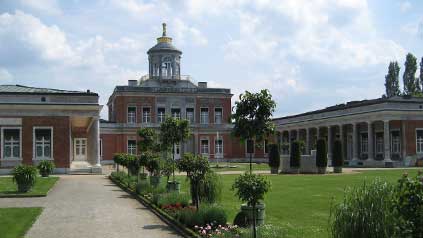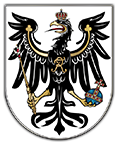
Built in the early classicist style, the Marble Palace or Marmorpalais in Potsdam is located on the banks of the Heiligen See in the New Garden. Commissioned by Frederick William II, the palace was built between 1787 and 1792. It was designed by Carl von Gonthard and Carl Gotthard Langhans, who later also designed the Brandenburg Gate. Built as a private residence for the king, the Marble Palace has stunning views of the surrounding gardens and the River Havel, as well as Peacock Island.
The two-storey building resembles a square and is built with red brick. Its flat roof is crowned by a round pavilion, which offers wonderful views of Potsdam and the surrounding countryside. A stairway and gallery are accessible from the roof into the belvedere.The palace’s name is derived from the grey and white Silesian marble used for decorative and structural elements on the façade. A large terrace with lateral stairways leads directly down to the lake. Under the terrace is the palace kitchen, which was built by Langhans between 1788 and 1790 to resemble partially buried temple ruins. An underground passage connects the kitchen with an artificial grotto on the ground floor of the palace, which was used in the summer as a dining room.
Frederick William II started work on extensions to the Marble Palace prior to his death in 1797. After his death, his son Frederick William III continued to the work. Designed by Michael Philipp Boumanns, the extensions to the Marble Palace consisted of two rectangular, single-storey wings that were connected with galleries in a quadrant. The colonnades in the Sanssouci Palace in Potsdam were demolished in order to obtain the marble needed for the Arcades in the new wings.Beginning in 1833, the Marble Palace served as residence for then Prince William, later Kaiser William I, and his wife Victoria Augusta. They lived in the palace until the Babelsberg Palace was completed in 1838. William’s brother Frederick William IV of Prussia commissioned Ludwig Ferdinand Hesse to design the interior of the Marble Palace’s two side wings. Work on the extensions was carried out from 1843 until 1848, when beautiful frescos in the arcades were added. Between 1881 and 1888, the future Kaiser William II lived in the Marble Palace. During this time, technical and sanitary facilities were updated in the buildings. Crown Prince Wilhelm and his wife Cecilie also lived in the palace from 1904 to 1917 before moving into the nearby Cecilienhof Palace.
In 1926, the Marble Palace was placed under the control of the Prussian Palace Department and was re-opened in 1932 as a museum. During World War II, the palace suffered serious damage when an incendiary bomb hit the north wing. A grenade also damaged the main building. After the war the building was used as an officers’ mess by Soviet troops and an Army Museum from 1961.Restoration of the building began in 1988 under the direction of the National People's Army, and later, under the leadership of the Palace Department. Since 2006, the fully restored palace has been open to the public.
- Saturday, Sunday & public holidays: 10:00 - 16:00 clock
- Saturday, Sunday & public holidays: 10:00 - 18:00 clock
- Tuesday to Sunday: 10:00 - 18:00 clock
Events in Potsdam
ticket sales
Music Festival in PotsdamThe Music Festival in Potsdam will be held again in June. This year's theme "Music and gardens" ubiquitous. So even on the opening day in June. Interesting and unique you can take guided tours and visits to many different places. For those interested there is an Opera Workshop.
TICKETSDetails about the Music Festival in Potsdam can be found here.
The concert on the eve and Night of the Palaces in PotsdamThe Park of Sanssouci and Sanssouci Palace with its terraced vineyards and the New Palace are undisputedly the most important monuments in Potsdam, therefore provides the Night of the Palaces as an excellent temporal orientation, to learn more about the state capital of Brandenburg.
TICKETSDetails about the Night of the Palaces can be found here.



